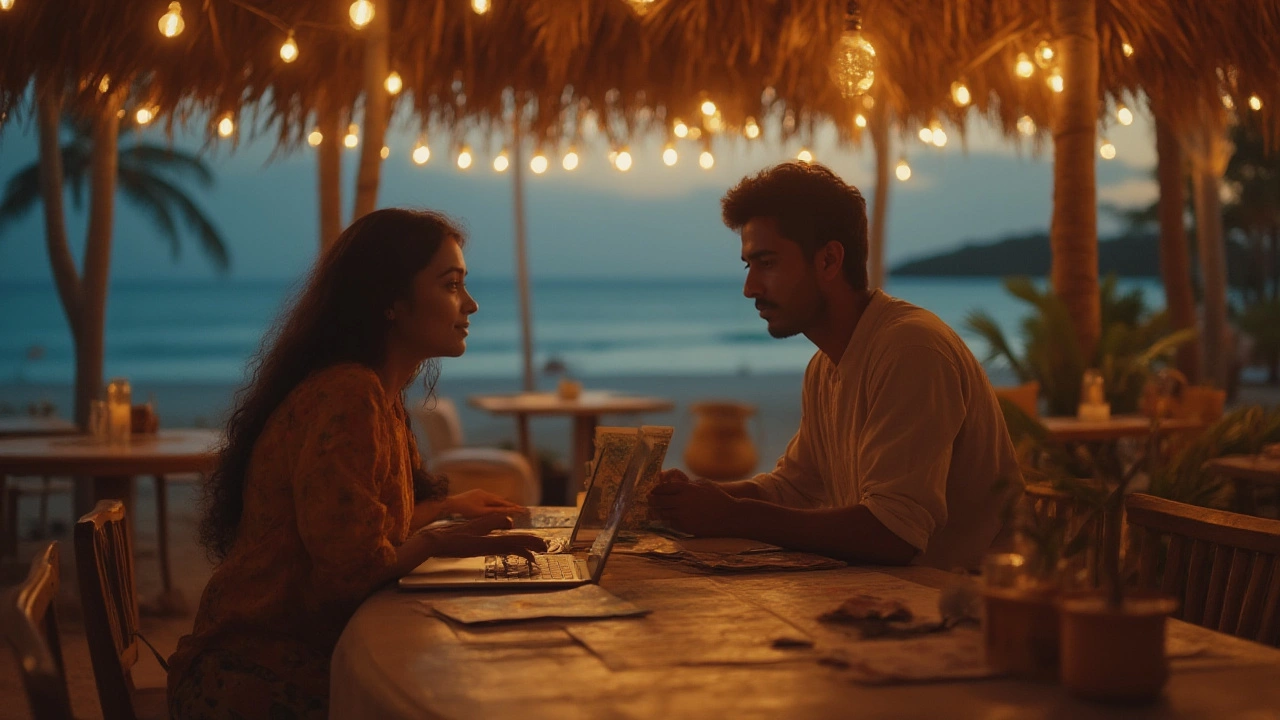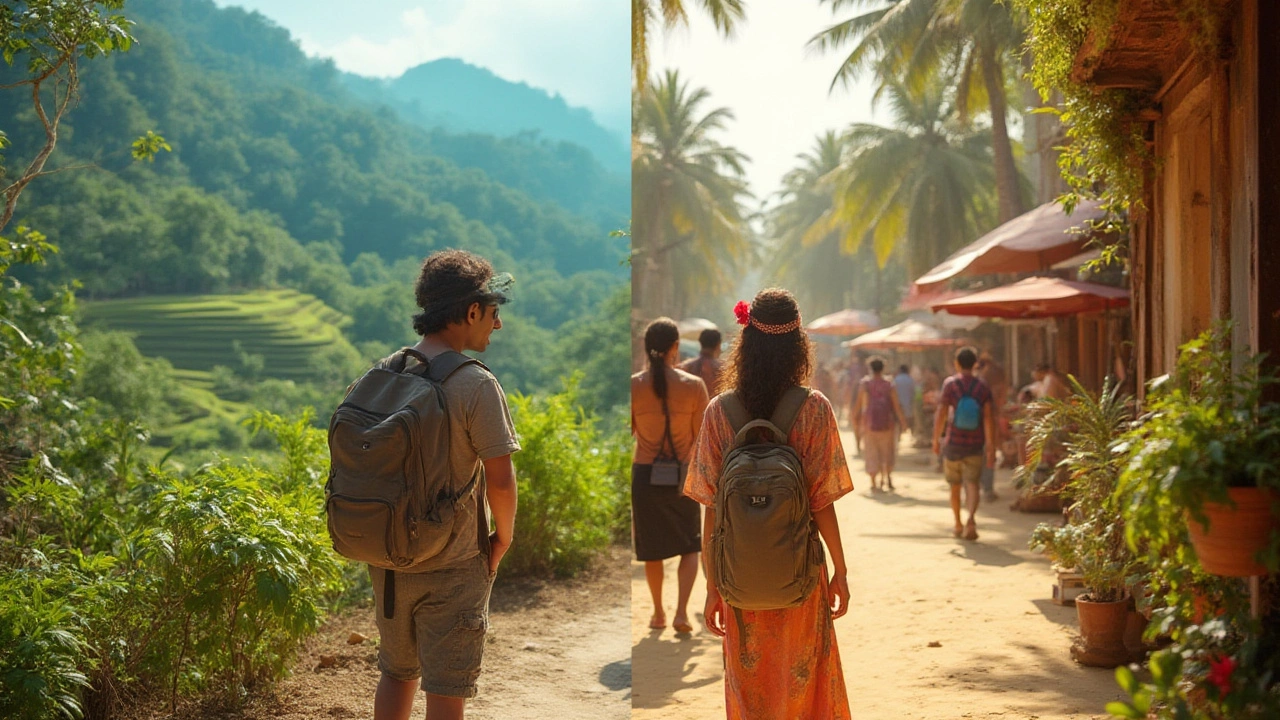Picture this: warm breezes, powdery sand, sticky coconut drinks in hand. People often dream of either Bali or Goa for their next escape. But ask around, and wild stories fly about how much you’ll spend in each spot. Some swear Bali will eat your wallet. Others claim Goa’s gotten pricey. Digging into real costs and trickier bits, let's see who really wins on price—because nobody likes a surprise bill at checkout.
How Much Do You Really Spend: Flights, Hotels, Food, and Getting Around
It’s tempting to look at gorgeous beach photos and assume both places are equally easy on the pocket. The truth isn’t that tidy. First up? Getting there. Most people fly into Bali (Ngurah Rai International Airport) or Goa (Dabolim International Airport). If you’re Indian and flying from Mumbai, Goa is hard to beat on airfare—budget airlines sometimes nail it for under ₹5,000 round-trip. Bali, on the other hand, nearly always involves international flights. In 2025, flights from Delhi or Mumbai to Bali often hover around ₹20,000-₹40,000 for a return ticket in economy. Indonesians and nearby Southeast Asian travelers snap up even cheaper promo fares sometimes as low as $100, but if you’re coming from Europe, a return trip can reach $700 just in airfare.
Now, about those rooms: Goa’s got quirky guesthouses, backpacker hostels, homestays, basic resorts, and fancy five-stars. You can snag a simple guesthouse room for ₹600-₹1,000 a night in North Goa if you don’t mind a fan instead of A/C (mid-July is rainy and cheap, December costs triple for New Year’s parties). Bali’s hostel beds start at $6 (about ₹500) and cheap guesthouses (locally called homestays) commonly go for $10-$15 per night, including breakfast. While Goa once ruled for rock-bottom rooms, Bali’s hostels and family-run places have gotten fierce. Of course, you’ll see endless Instagrammable Bali villas, fluffy towels, and floating breakfasts for $80–$250 a night. Truth is, there are plenty of family-run Balinese compounds inside rice fields starting at $10–$15 that still throw in a (very decent) omelet and Bali coffee. Goa’s beach shacks aren’t that far off pricewise in off-season, but luxury and boutique properties in both places can burn through your rupee (or dollar) fast.
Eating out is where Bali shines for budget travelers who stick to warungs (local food stalls). Expect a flavorful nasi campur (mixed rice and toppings) for $2, and a fresh juice for $1. Fancier tourist restaurants in Seminyak charge $5–$10 for a Western-style breakfast, still a bargain by global standards. Goa’s thali lunches in small joints start at ₹100-$200 (about $1–$2), and fish curry rice can hit ₹300–₹500 in more touristy areas. Western and beachside cafes in both destinations crank up prices: a pizza in Canggu, Bali costs $5–$8, in Anjuna, Goa, it’s ₹600–₹900, roughly the same. By the way, Bali’s coffee scene—famous for piccolo lattes and cinnamon-dusted toasts—costs about $2–$4 per cup. Goa matches that with strong filter coffee for ₹80 in a shack, or ₹300 in a trendy Mapusa cafe.
Getting around is another expense folks forget. Goa runs on rented scooters (₹400–₹600 day), taxis (no meters, prices fluctuate wildly), and auto rickshaws. In Bali, everyone seems to scoot around too, rentals cost $5–$7 per day, gasoline is under $2 for a full tank, and rideshare apps like Grab and Gojek keep rides reliable. Warn of Bali’s new traffic traps: Canggu to Seminyak at sunset can take over an hour for 10 km. In Goa, those lovely back roads come pothole-studded and unlit.
| Expense | Bali (INR) | Goa (INR) |
|---|---|---|
| Hostel/Basic Room (per night) | 600–1500 | 600–1500 |
| Mid-range Hotel (per night) | 3000–7000 | 3500–8000 |
| Luxury Resort (per night) | 9000–25000+ | 10000–22000+ |
| Local Meal | 150–300 | 120–250 |
| Scooter Rental (per day) | 400–600 | 400–600 |
| Beer (restaurant/bar) | 180–300 | 120–200 |
| Taxi/Transport (10km) | 350–600 | 300–700 |
| 30-day VISA | 2,800 | 0 (for most Indians) |
Hidden fees? Bali stamps you for about INR 2,800 in Visa on Arrival fee, while Indians enjoy free-entry for Goa (duh, it’s the home crowd). Bali’s tourist tax launched in 2024 is a one-time 150,000 IDR (roughly ₹800). Both have their sneaky extras—refillable water is rare in Goa, so bottles add up; Bali’s temple attractions can suddenly ask for cash for sarong hire.

Price Surprises: Shopping, Activities, and Nightlife
You’d think the market is the market—isn’t everything dirt cheap? Not always. Goa at the old Mapusa or Anjuna flea market isn’t what it was in the ‘90s. T-shirts that once went for ₹250 now cost ₹500–₹800, and chunky silver jewelry racks up ₹2,000–₹5,000 for a chunky bracelet, especially if you look touristy. Bargaining is still a thing, but most vendors hold prices higher from October to March. Bali’s Ubud market might look more refined, but be prepared to pay $12–$20 for a dress, and $5–$8 for the handmade rattan bags Instagram influencers love, prices similar to Goa’s Anjuna shops. Luckily, supermarket prices for toiletries and snacks in Bali (Indomaret chain stores everywhere) stay surprisingly low, especially Indonesian snacks and bottled water at $0.30.
Want adventure? Bali’s rice terrace swings cost about $10–$15 a pop, monkey forest entries charge $6, and to climb Mount Batur for sunrise you’ll need a “guide” (it’s the law) costing $30–$50 per person. Goa’s waterfall treks—think Dudhsagar—mean anything from ₹400 local tours to ₹2,500 if run by posher resorts. Scooting yourself is definitely the cheap way. Watersports in North Goa—parasailing, jet-skiing, banana rides—start at ₹500–₹1,000 per ride, similar to Bali’s Tanjung Benoa strip.
Yoga is famously budget-friendly in both places. A drop-in class in Bali’s Ubud runs about $7–$10, multi-day passes are cheaper. In Arambol, Goa, group classes can be as little as ₹400–₹700. Goa shines for no-frills music gigs where a cover charge is rare. Clubbing in Bali’s Kuta or Seminyak, expect cover fees of $10–$20, and drinks to match. Goa’s legendary beach parties might ask for ₹1,000+ cover in high season, but usually just buy a drink and dance. Cocktails can be outrageous at Bali nightclubs—$12 a pop isn’t weird—while happy hour mojitos in Anjuna can be had for ₹250.
One fun fact: alcohol gets pricey in Bali, thanks to Indonesia’s high taxes on booze. A small Bintang beer bottle might set you back $2.50–$3.50 in a bar; a Kingfisher in Antares Goa rarely passes ₹200. Imported booze in Bali? Double the supermarket price tag compared to Goa, where even a basic gin is reasonable. Bali’s the better bet for cheap, good coffee. Goa wins with locally brewed feni for a few coins.
Both Bali and Goa tempt you with classes—cooking, surfing, ceramics, macrame. In Bali, a group cooking class costs $25–$35 (think hands-on Balinese spice pastes and satay skewers). In Goa, those workshops are rarer and usually aimed at foreigners, and a Goan fish curry lesson will run ₹1,800–₹2,500. Surf lessons in Kuta are $15–$25, Goa’s Mandrem surf schools hit ₹1,500–₹2,500 for a group lesson. It evens out on most hands-on activities.
If you came just to sunbathe? Bingo—the sand’s free in both. Surf schools and yoga studios, however, feel lighter on the wallet in Bali, but Goa remains the king if you lean into low-key, local-run gigs.

How To Save More: When, Where, and Unexpected Costs
Before scrolling Instagram for next weekend's flight, consider the calendar. Goa is seasonal—come between June and September and nearly every rate drops (except anything on Saturday night in rainy North Goa). From late December to early January, almost nothing in Goa qualifies as cheap. Room prices can triple and you’re fighting locals with holiday plans. Try October or mid-February to snag beach shack deals before crowds hit. Bali is always busy—Europeans come in summer and Aussies in winter, but prices don’t spike quite as sharply. It rains more from December to March, but you'll find sweet discounts on villas during these storms.
Hidden costs lurk everywhere if you’re not sharp. In Goa, ATMs (besides premium ones) have withdrawal fees for foreign cards—sometimes ₹200–₹400 per pop. Mobile data, if your home plan doesn’t cover it, is cheap in both places (about $3 for a local SIM). Bali wins for perks: most cafes, even the crummy ones, offer free (and fast) WiFi. Goa’s connection is famous for cutting out at sunset right when you want to Snapchat your mojito. In Goa, you’ll pay ₹30–₹50 for a basic water bottle. Bali restaurants mostly serve free filtered water, and refill stations dot the tourist zones.
Day tours in both places often include your transportation, so check the fine print, especially for temple or waterfall visits. Bali’s temples have mandatory sarong hire (about $1); Goa’s religious sites are usually free, except the odd ₹20 camera fee. Renting a scooter? Bali’s police are notorious for ‘checking’ tourists' licenses and coming up with fines, sometimes $10–$20 cash. In Goa, the cops ease up if you’re helmeted, but be firm—some traffic stops are classic scams.
| Best Value Tips | Bali | Goa |
|---|---|---|
| Eat Local | Warungs: $2 meals | Thali/curry house: ₹120 |
| Stay Smart | Ubud homestay: $10+ breakfast | Beach shack: ₹700 off-season |
| Avoid Price Spikes | Avoid July-August, book in May | Avoid Christmas/New Year week |
| Drinks | Coffee: $2, Beer: $3.50 | Filter coffee: ₹80, Beer: ₹160 |
| Local Transport | Grab scooter rides | Bus or share auto |
Buy souvenirs? Test your bargaining skills! In Bali, always cut the asking price in half and walk away if you’re not convinced—the vendor will almost always chase you down. Goa’s sellers, especially in Anjuna, expect some haggling but less drama than before. Bring cash—credit cards in Bali are more widely accepted, but in small shops both places, cash is king and ATM fees sting.
Visa and entry fees can shake up your budget too. Indonesia’s visa on arrival keeps creeping up (now about $35), so add that into your plan. Goa has no entry fee for most nationalities, and even for foreigners, e-visas are quick and cheap. Little things add up fast, like sunscreen (imported brands are expensive both places, so toss one in your bag before you go), or a power bank (high markup in Bali tourist shops!).
Just want to laze on the beach and sip cheap drinks? Goa edges out Bali. But if you love chasing waterfalls, endless rice fields, and don't mind spending a little more up front for flights, Bali vs Goa becomes more about experience than pennies. Both places offer deals, splurges, and hidden fees, but smart choices can keep prices in check no matter where you drop your flip-flops.
